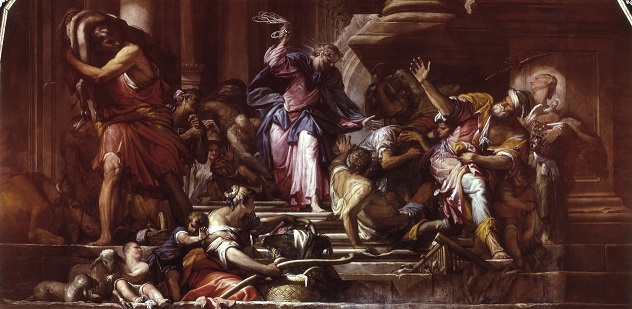Paintings by Tintoretto and Fumiani
The Church of San Rocco contains two large canvases restored by the Swiss Pro Venezia Foundation in 1987: SAINT ROCH CAPTURED AT THE BATTLE OF MONTPELLIER and CHRIST DRIVING THE MERCHANTS FROM THE TEMPLE.
The first, on the right side wall of the church, is attributed to Jacopo Robusti (Venice, 1518 - 1594), more famous as Tintoretto and also known to his contemporaries as “il furioso” because of the extraordinary speed with which he painted, a reputation that brought with it frequent accusations of superficiality and of unfair practices by his fellow artists. For a short time a pupil of Titian, later to become his great rival, he was an original and innovative practitioner of the XVI century Mannerist style and according to many critics laid the bases for the future development of Baroque art. The viewer is always struck by the dramatic composition of most of his many works, by the dynamic and emotional tension of the figures and by sudden gashes of light appearing between dark storm-clouds… In this particular painting, the less than convincing examples of these and other distinctive expressive features suggest that Tintoretto’s assistant painters probably played a substantial part in its production.

The subject develops an incident from one of the semi-legendary biographies of Saint Roch, the XIV century pilgrim miracle-worker whose remains have been kept in the church since 1490. Born in Montpellier, the only child of well-to-do parents, he decided on their death to dispose of all the family goods and privileges and at the age of just twenty he went to Rome, to pray at the tombs of the Apostles Peter and Paul. In those times Italy was afflicted by repeated epidemics of the plague and during the journey he made a point of doing all he could to help the sick. On his return journey he was captured by a detachment of the King of France’s army besieging his home town; his refusal to reveal his identity meant he could not defend himself from the accusation of being an enemy spy and was imprisoned. He was not recognised until his death after five painful years in gaol.
The second canvas, on the opposite wall, depicts an episode recounted in all four Gospels, though St. John’s is the more dramatic: “And the Jews’ Passover was at hand and Jesus went up to Jerusalem, and found in the Temple those that sold oxen and sheep and doves, and the changers of money sitting; and when he had made a scourge of small cords he drove them all out of the Temple, and the sheep and the oxen; and poured out the changers’ money and overthrew the tables”.

The artist in this case (presumably in 1678) was Giovanni Antonio Fumiani (Venice ca. 1645 - 1710). He started his career as an apprentice to a painter in Bologna, where he developed a taste for depicting the grand architectural perspectives that remained a distinctive feature of his art. He returned to Venice in 1668 and built up a flourishing practice, with regular commissions from the Church and private individuals. He also enjoyed some success outside Venice, as shown, for example, by another Cleansing of the Temple which he painted for the Prince of Liechtenstein Johann Adam Andreas. His best-known work occupied him for a considerable time in the Church of San Pantalon, where the ceiling is completely covered by a canvas painting depicting the Martyrdom and glory of St. Pantalon, offering strikingly vibrant effects and astonishing three-dimensional depth.
Permission to reproduce the illustrations has kindly been granted by the Scuola Grande and Arciconfraternita of San Rocco, which is also the owner of the church.

